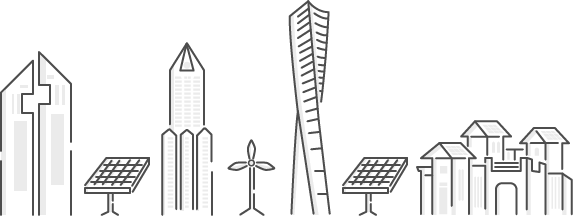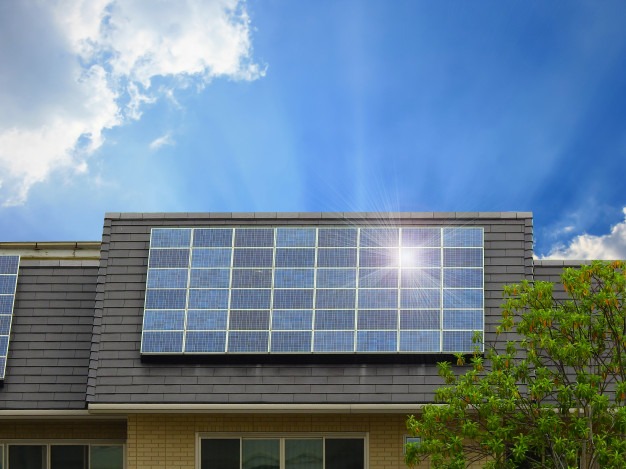Solar energy is one of the most reliable forms of energy available for our homes and buildings. Thanks to the technological advancements in this industry that has led to the cost of going solar reduce every year. In recent years, many homeowners are considering the option of adding a solar energy system to their home roof to harness the sun’s energy. Roof-top solar panel systems fitted to the roof of the building is known as photovoltaic systems that act as a power station to generate electricity using the radiation emitted by the sun. The solar panel can fit any building from mid to large-scale residential and commercial complexes as well. But before you take the leap to fit in the solar panel system, read these facts to know some interesting facts about residential roof-top solar panels for homes.
-
From what solar panels made?
A solar PV module consists of main components such as solar cells, EVA sheet, back sheet, and a frame. The term solar panel is commonly used for the phot-voltaic module, which is an assembly of solar cells. This assembly of solar cells also called photovoltaic cells mounted in a framework for installation.
Thus, at the cell structure level, different types of raw materials used in manufacturing solar panels. Those are mono silicon, polysilicon, or amorphous silicon panels.
Step 1: Sand: The main raw material used in making solar panels is pure silicon. It all starts with sand, the raw material from which silicon is extracted. The sand is subjected to a highly intensive process where high purity silicon is produced in an arc furnace at high temperatures.
Step 2: Ingots: Ingots come in between the transformation of silicon to solar-grade finished solar cells. These cylindrical-shaped, melted compounds made from silicon rocks. When these ingots sliced into thin disks, we get wafers.
Step 3: Wafers: The solar wafer is a highly pure, defect-free single crystalline material, and a thin slice of crystalline silicon (semiconductor) that works as a substrate for microeconomic devices. They used for fabricating integrated circuits in photovoltaics (PVs) to manufacture solar cells. This wafer is the main component in the power generation system of PV to convert sunlight energy directly into electrical energy.
Step 4: Solar cells: Solar cells formed by coating solar wafers with metal conductors capable of capturing sunlight and generating electricity. All solar cells joined together to form a matrix-like structure called solar panels.
The finished solar cells then encapsulated into silicon rubber or ethylene-vinyl acetate. These encapsulated solar cells then arranged into an aluminum frame that has a mylar or Tedlar back the sheet and a glass or plastic cover.
-
What are the types of solar panels available in the market?
There are three types of solar panels available for the Solar PV system are Monocrystalline, polycrystalline and thin-film solar
- Monocrystalline –The solar cells cut from an ingot made from a single large crystal of silicon. Monocrystalline panels are generally more expensive and space-efficient and are the most preferred choice for residential purposes.
- Polycrystalline– These panels from an ingot made up of many small crystals of silicon. These are less expensive and have slightly lower heat tolerance when compared to monocrystalline.
- Amorphous Silicon panels– also called thin small solar cells thin, small panels made up of several layers of photovoltaic material.
Based on these solar panel advantages, one must choose suitable solar panels and also must consider the reasons to choose solar energy for homes.
-
Why is it important to use Silicon in manufacturing solar panels?
Currently, more than 90% of the current solar cell market is based on silicon. Silicon is one of the best conductors of heat because it has a spectrum-like structure to capture a large amount of radiation. The solar cells made of silicon atoms connected to form a crystal lattice, that provides an organized structure. That makes the conversion of light into electricity more efficient. This is the reason why silicon is the most used element in the circuit industry.
-
Any pollutants involved in making solar panels?
Solar panels do not emit any kind of harmful greenhouse gases during the process of energy production. They do not use any other component which is not readily available but only the sunlight.
-
How long does it take to produce electricity from solar panels?
Sunlight takes approximately 8 minutes to reach the surface of the earth and just a fraction to come in contact with solar panels. Hence, the Solar power system does not even make its customers wait to generate electricity.
-
What is solar power statistics in UAE?
Solar power in the UAE has the potential to provide most of the country’s electricity demand. While being a major oil-producing country, and one of the top carbon dioxide emitters the UAE has taken steps to introduce solar power on a large scale to generate the vast majority of its electrical energy by 2050 from renewable energy. The Dubai Clean Energy Strategy aims to provide 7% of Dubai’s energy from clean energy sources like solar energy by 2020 and increases this target to 25% by 2030 and 75% by 2050.
Sustainable energy sources such as solar energy are gaining popularity all over the world. Reduce your carbon footprint and nerve-racking electricity bills by getting solar panels for your home through the best installers.
As a leading solar energy provider in Dubai, Wattz provides you with the best quality residential solar power system. To get suitable home solar panels or installation services, reach us at info@wattz.ae or contact @ +97142594454





